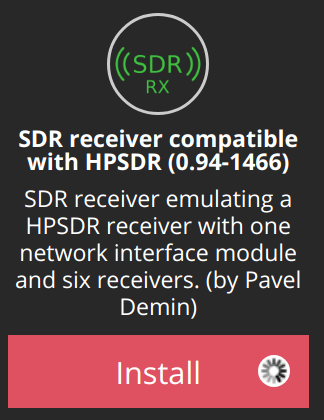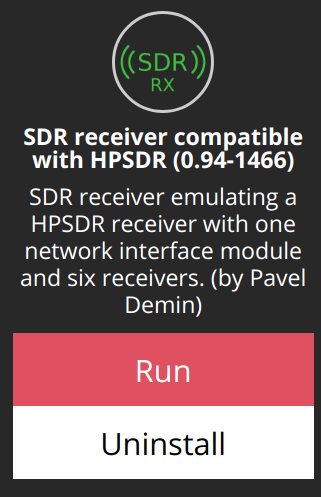Setup Red Pitaya for six HPSDR receivers
Setup Red Pitaya HPSDR receiver image: format a micro SD card to FAT32.
Find the SD card device name from df – be sure you don’t overwrite your hard drive!
lsblkSuppose the SD card is at /dev/mmcblk0:
umount /dev/mmcblk0
mkdosfs -F 32 -n HPSDR6rx /dev/mmcblk0Download the latest .img.zip Red Pitaya beta Ubuntu image and then extract to the SD card:
mount /dev/mmcblk0 /mnt/HPSDR6rx
unzip -p redpitaya_ubuntu*.img.zip | sudo dd of=/dev/mmcblk0 bs=4M
syncBoot the Red Pitaya with this SD card. Connect to Red Pitaya via Ethernet using SSH using Avahi.
ssh root@redpitaya.localor via serial port
Via the web browser Red Pitaya control panel, install Pavel’s six receiver HPSDR app.
On the
Red Pitaya add the following to rc.local to auto-start the HPSDR server
# Start the SDR Receiver compatible with HPSDR at boot time
cat /opt/redpitaya/www/apps/sdr_receiver_hpsdr/sdr_receiver_hpsdr.bit >/dev/xdevcfg
source /opt/redpitaya/www/apps/sdr_receiver_hpsdr/start.shreboot the Red Pitaya

Install Pavel Demin six-receiver HPSDR from Red Pitaya marketplace.

Run Pavel Demin six-receiver HPSDR from Red Pitaya marketplace (actually see step #6 to make HPSDR server autostart on boot).
Check HPSDR server
On the Red Pitaya (or via serial/SSH)
ps aux | grep hpsdrYou should see
/opt/redpitaya/www/apps/sdr_receiver_hpsdr/sdr-receiver-hpsdr 1 1 1 1 1 1
Where all the 1’s mean that each receiver is using RX1 SMA connector.
You can configure each of the receivers to use RX1 or RX2.
There are several HPSDR compatible programs such as GNU Radio Companion HPSDR client:
apt install gnuradio gr-hpsdrIf the Ubuntu repository gr-hpsdr is out of date, be sure the default gr-hpsdr works for you, then consider the current Github:
git clone https://github.com/Tom-McDermott/gr-hpsdrfor the Cmake command, you may need to tell which directory gnuradio-runtime.pc is in to avoid
GnuRadio Runtime required to compile hpsdr
PKG_CONFIG_PATH=/usr/lib/x86_64-linux-gnu/pkgconfig cmake -B buildPrereqs you’ll need include
libboost-all-dev
libgsl-dev
libczmq-devMake a block diagram with GNU Radio Companion, using the hermesNB or hermesWB blocks.
If it doesn’t work, try
make uninstallnote that the version 1.2 of gr-hpsdr didn’t seem to update the connection between Gnu Radio Companion and the modules yet.
Use the top_block.py directly in Python e.g.
python top_block.pyIt seems that GNU Radio ≥ 3.7.10 is needed as 3.7.9 just hangs waiting for connection.
If building GNU Radio, be sure to remove the system-installed gnuradio first.
apt remove gnuradioIf you get error
ImportError: libgnuradio-runtime-3.7.10.so.0.0.0: cannot open shared object file: No such file or directory
Ensure that /usr/local/lib is in LD_LIBRARY_PATH by in your ~/.profile adding the line
export LD_LIBRARY_PATH=$LD_LIBRARY_PATH:/usr/local/libWindows only: OpenHPSDR PowerSDR mRX PS
Related: Red Pitaya GNURadio image setup